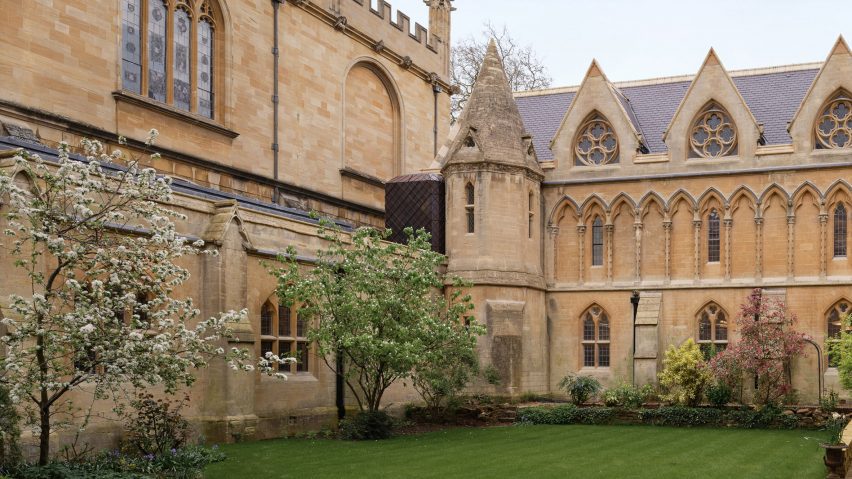British architecture studios Nex and Donald Insall Associates have renovated Exeter College's neo-gothic library at the University of Oxford, originally constructed by George Gilbert Scott in 1857.
Addressing a need for additional study spaces and improved accessibility of the Grade II-listed building, the studios implemented a series of contemporary interventions including the addition of new entrances, a staircase and a lift.
"The first [challenge] was really to repair it, and reinstate and actually reveal some of the most important elements of the building that had been obscured over a century of incremental change," Nex founding director Alan Dempsey told Dezeen.
"The second key thing was to improve accessibility, user comfort and experience."
Located beside the Grade I-listed Bodleian Library, Exeter College's Jackson Library is arranged in an L shape composed of a two-storey study space and an annexe.
A key measure to improve the library's accessibility was renovating a discreet single-storey structure – previously used as a storage space – which was repurposed to create a new entrance and operates as a "hinge" connecting the two library wings.
Students enter via a rounded wooden door punctured with a crest-shaped opening and framed by an arch carved of Clipsham stone that offers a "contemporary interpretation" of the surrounding masonry.
Inside, the lobby is finished with oak-lined walls and ceilings that complement the new and existing stone features, warmed by a glazed entrance coloured in "Exeter red" that leads into the adjacent annexe.
Two circular skylights draw daylight into the entrance space.
Highlighted in the lobby is the new lift, encased by striking cast-iron cladding with a diamond-shaped pattern that nods to the leadwork on the nearby Exeter College Chapel, also designed by Scott.
This iron structure is also visible on the building's exterior, nestled behind an existing stair turret that leads up to the second floor.
Beyond the glazed entrance, the annexe opens up into a bright study space lined with bookshelves.
A row of new clerestory windows was added to complement the full-height original glazing, which had previously been bisected by a mezzanine floor added in the 1950s.
To improve the space's proportions, Nex lowered the ground floor level and replaced the full-width mezzanine with a 14-metre-long cantilevered timber balcony overlooking the study space, accessed via a staircase in the lobby and another at the annexe's opposite end.
Hidden within the space are two small rooms for work and storage that are revealed behind two swivelling bookcases, identifiable by semicircular brass detailing on the floor.
The building's larger wing features oak study desks divided by the library's existing bookcases, which were retained and restored.
Here, steel beams added in the 19th century to reinforce the floor were replaced by a new hidden floor structure to reveal the original ceiling design.
Rounded strip lighting and pendant lights provide focused illumination throughout the study spaces.
Donald Insall Associates, an architecture firm and historic buildings consultancy founded in 1958, was responsible for overseeing the conservation of the building's envelope.
This included the repair of a row of Ashlar stone windows, walls and roofs, alongside the addition of new heating services and acoustic and thermal insulation to improve the building's environmental performance.
"The main focus of the repairs [was] on the exterior envelope and on the internal bookcases," said Michele Verdi, an associate at Donal Insall Associates.
"Externally, the stonework at a high level was in pretty bad shape," Verdi added.
"The slates on the roof too were not in good condition [so] we took the opportunity to reuse whatever could be salvaged, but also to insulate [the roof] so that we could give extra thermal performance to the building."
Elsewhere at the University of Oxford, London studio Wright and Wright recently completed its redevelopment of St John's College, which involved the restoration of two libraries and a 17th-century courtyard.
Other recent developments on university campuses include an oak-framed wing extension to Cambridge's Clare College and the new London College of Fashion building completed by Allies and Morrison in east London.
The photography is by Will Pryce.

